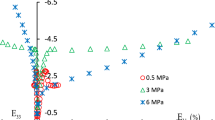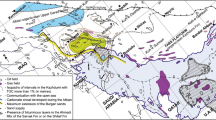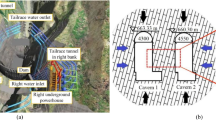Abstract
This article uses the Kirchhoff transformation method to solve a non-steady one-dimensional diffusion equation when the apparent diffusion coefficient is expressed as a function of time, depth, and concentration of chloride for concrete exposed to chloride environment. The analytical results obtained by the proposed method, which are coincided with those calculated from the Boltzmann–Matano methodology under specific condition, can be used to conveniently predict the chloride diffusion process physically and chemically so that the traditional natural diffusion test to obtain time/depth dependent apparent diffusion coefficient may be greatly simplified. Two new simplified methods to effectively process the experimental results from the natural diffusion test are proposed: one is called the long-specimen-at-one-specific-time method using fewer specimens at one time and the other the short-specimen-at-long-elapsed-time method using more specimens at various service times. Two numerical examples are provided to illustrate the application of these two proposed methods.








Similar content being viewed by others
References
Kropp J, Hilsdorf HK (1995) In: Performance criteria for concrete durability. E& FN Spon, London
Truc O, Ollivier JP, Carcassès M (2000) Cem Concr Res 30(2):217
Tang L, Nilsson LO (1992) ACI Mater J 89:49
Castellote M, Andrade C, Alonso C (1999) Mater Struct 32:180
Friedmann H, Amiri O, Aït-Mokhtar A, Dumargue P (2004) Cem Concr Res 34:1967
Dhir RK, Jones MR, Ahmed HEH, Seneviratne AMG (1990) Mag Concr Res 42(152):177
Castellote M, Andrade C, Alonso C (1999) Cem Concr Res 29(11):1799
Andrade C, Sanjuán MA, Recuero A, Río O (1994) Cem Concr Res 24(7):1214
Stanish K, Thomas M (2003) Cem Concr Res 33:55
Tumidajski PJ, Chan GW, Feldman RF, Strathdee G (1995) Cem Concr Res 25(7):1556
Černý R, Pavlík Z, Rovnaníková P (2004) Cem Concr Compos 26:705
Dhir RK, Jones MR, Ng SLD (1998) Mag Concr Res 50(1):37
Midgley HG, Illston JM (1984) Cem Concr Res 14:546
Maage M, Helland S, Poulsen E, Vennesland Ø, Carlsen JE (1996) ACI Mater J 93-M68:602
Zhang T, Gjørv OE (2005) ACI Mater J 102-M33:295
Dhir RK, El-Mohr MAK, Dyer TD (1997) Cem Concr Res 27(11):1633
Baroghel Bouny V, Chaussadent T, Raharinaivo A (1995) In: Nilsson LO, Ollivier JP (eds) Chloride penetration into concrete. RILEM, France, p 290
Tang L (1999) Cem Concr Res 29:1463
Tang L (1999) Cem Concr Res 29:1469
Tang L, Gulikers J (2007) Cem Concr Res 37:589
Brebbia CA, Telles JC, Wrobl LC (1984) In: Boundary element techniques: theory and application engineering. Springer-Verlag, New York
Kane JH (1994) In: Boundary element analysis: in engineering continuous mechanism. Prentice Hall, Englewood
Gebhart B (1993) In: Heat conduction and mass diffusion. McGraw-Hill Inc, New York, p 19, 28
O’Neil PV (2003) In: Advanced engineering mathematics, 5th edn. Brooks/Cole-Thomson Learning Inc., CA
Wolfram Research (1999) In: Mathematica user manual, version 4.0. Trade Center Drive, Champaign, IL 61820-7237, USA
Carslaw HS, Jaeger JC (1959) In: Conduction of heat in solids, 2nd edn. Oxford University Press, New York
Maage M, Helland S, Poulsen E, Vennesland Ǿ, Carlsen JE (1996) ACI Mater J 93(6):602
Tumidajski PJ, Chan GW (1996) Cem Concr Res 26(4):551
Liang MT, Lan JJ (2003) J Chin Inst Eng 26(5):647
Liang MT, Lin SM (2003) Cem Concr Res 33:1917
Liang MT, Jin WL, Yang RJ, Huang NM (2005) Cem Concr Res 35:1827
Nokken M, Boddy A, Hooton RD, Thomas MDA (2006) Cem Concr Res 36:200
Author information
Authors and Affiliations
Corresponding author
Rights and permissions
About this article
Cite this article
Sun, YM., Chang, TP. & Liang, MT. Kirchhoff transformation analysis for determining time/depth dependent chloride diffusion coefficient in concrete. J Mater Sci 43, 1429–1437 (2008). https://doi.org/10.1007/s10853-007-2304-4
Received:
Accepted:
Published:
Issue Date:
DOI: https://doi.org/10.1007/s10853-007-2304-4




